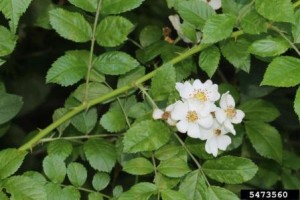Multiflora rose is a large, dense shrub that has escaped from ornamental and conservation plantings to become a serious invasive plant problem across the eastern half of the U.S. It invades natural areas, pastures, and light gaps in forests. Multiflora rose produces abundant small white flowers in the spring. Birds and mammals consume the red fruits, called hips, and may disperse them long distances. The majority of plants develop from seeds in the soil, which may remain viable for 10 to 20 years. It may also spread vegetatively when tips of arching branches touch the ground and develop roots (called layering), and from plants that emerge from shallow roots. Plants grow slowly for the first one or two years followed by rapid expansion through layering and root sprouts. Multiflora rose spreads quickly and may grow 1 to 2 feet per week to form impenetrable thickets of thorny stems.
A. Grubbing:
Pulling, grubbing, or removing individual plants is effective when plants are small. Use a digging tool to remove the entire plant. Special care should be taken to ensure that all roots are removed to prevent their re-sprouting. If plants develop from severed roots these should be removed as well.
B. Cutting:
This method is also appropriate for small initial populations and for environmentally sensitive areas where herbicides cannot be used. Repeated cutting will control the spread of multiflora rose, but will not eradicate it. Stems should be cut at least once per growing season as close to ground level as possible. Hand cutting of established clumps is difficult and time consuming due to the long arching stems and prolific thorns.
C. Mowing:
For disturbed areas containing large populations of multiflora rose, mowing of large bushes can provide partial control, by restricting top growth and spread. Research indicates that mowing three to six times a year can be effective. The objective of a mowing program is to clear the existing vegetation and reduce the reproductive capability of the below ground portions of the shrubs. As such, this is only a practical option in infested areas such as pastures where mowing equipment can operate. Mowing can also be somewhat effective in protecting a field or pasture from encroaching infestations on adjoining properties. Repeatedly mowing the perimeter of a site to block this type of expansion can be somewhat effective in preventing the spread of multiflora rose. In many cases where this weed is present, mechanical methods will not be an option, and chemical control options should be considered.
D. Herbicides:
Multiflora rose is susceptible to both glyphosate and triclopyr. Triclopyr can be applied starting in spring before or during flowering. Glyphosate is most effective when applied after flowering (early summer) until early fall. Cut-stump treatments with both herbicides also provide control, but cutting stumps in established thickets is very difficult because of the numerous thorny branches.
ROUNDUP [glyphosate (41%)]:
Foliar spray: 1.5 fl. oz./gal
Cut-stump treatment: Diluted with equal part water (1:1)
BRUSH-B-GON [triclopyr (8%)]:
Foliar spray: 4 fl. oz./gal
Cut-stump treatment: Undiluted
References
Ahrens, J. F. 1979. Chemical control of multiflora rose. Proceedings, Northeastern Weed Sci. Soc. 33:213-217.
Kay, S. H., W. M. Lewis, and K. A. Langeland. 1995. Integrated management of multiflora rose in North Carolina. North Carolina Cooperative Extension Service. 17 p.
Noxious and Nuisance Plant Information System, Version 4.0.
Szafoni, R.E. 1991. Vegetation Management Guideline: Multiflora Rose (Rosa multiflora Thunb.). Natural Areas Journal 11(4): 215-216.
Tennessee Exotic Plant Management Manual, April 1997.
